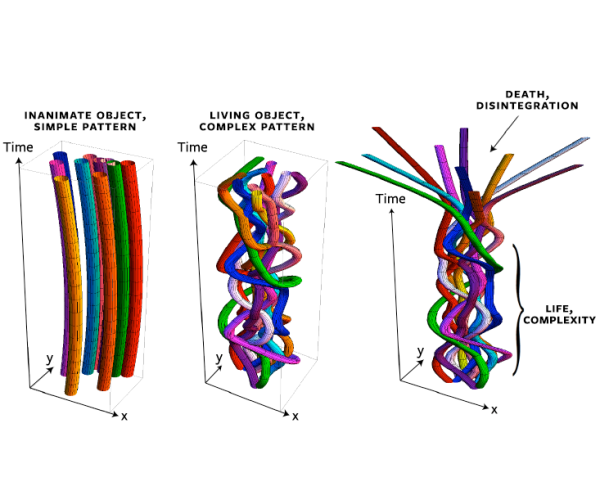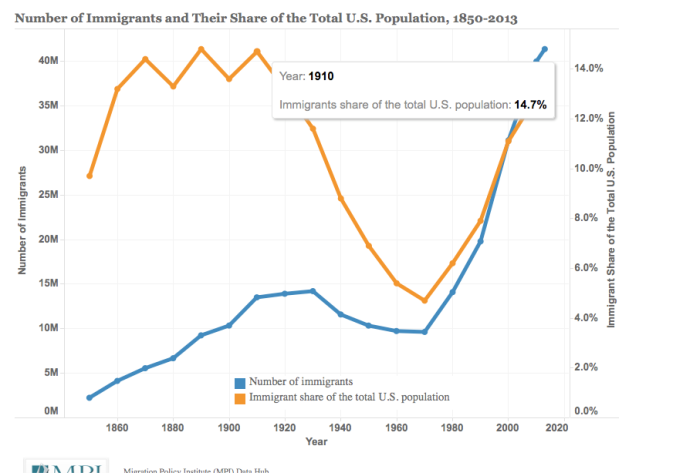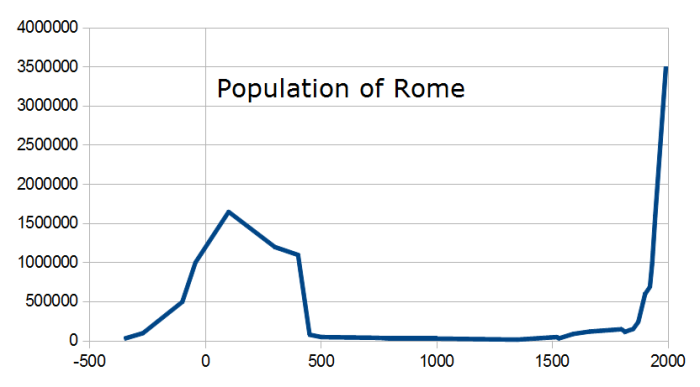Disease is the enemy of civilization. Wherever civilization arises, so does disease; many of our greatest triumphs have been the defeat of disease.
Homeostasis is the idea that certain systems are designed to self-correct when things go wrong–for example, when you get hot, you sweat; when you get cold, you shiver. Both actions represent your body’s natural, automatic process for keeping your body temperature within a proper range.
All living things are homeostatic systems, otherwise they could not control the effects of entropy and would fall apart. (When this happens, we call it death):

Non-living things, like robots and corporations, can also be homeostatic–by hiring new employees when old ones leave, or correcting themselves when they start to fall:
Like organisms, organizations that are not homeostatic will tend to fall apart.
For this post, we will consider four important forms of homeostasis:
- Normal homeostasis: the normal feedback loops that keep the body (or organization) in its normal state under normal conditions.
- Defensive homeostasis: feedback loops that are activated to defend the body against severe harm, such as disease, and reassert normal homeostasis.
- Inadequate homeostasis: a body that cannot maintain or reassert normal homeostasis.
- Over-aggressive homeostasis: an excessive defensive response that harms the self.
Normal Homeostasis
Normal homeostasis creates (and depends on) moderate, temperate behavior. Mundanely, when you have not eaten in a while, you grow hungry and so eat; when you have had enough, you feel satiated and so cease. When you have not slept in a long while, you grow tired and head to bed; when you have slept enough, you wake.
Obesity and starvation are both symptoms of normal homeostasis not operating as it should. They can be caused by environmental disorder (eg, crop failures,) or internal disorders, (pituitary tumors can cause weight gain,) or even just the individual’s psyche (stress renders some people unable to eat, while others cope with chocolate.)
If your body is forced out of its normal homeostatic rhythms, things begin to degenerate. After too long without sleep, (perhaps due to too many final exams, an all-night TV binge, or too many 5-hour energy drinks,) your body loses its ability to thermo-regulate; the hungry, cold, and malnourished lose their ability to fend off disease and succumb to pneumonia. Even something as obviously beneficial as hygiene can go too far–too much washing deprives the skin of its natural, protective layer of oils and beneficial microbes, leaving it open to invasion and colonization by other, less friendly microbes, like skin-eating fungi. Most of this seems obvious, but it took people a rather long time to figure out things like, “eating a 100% corn diet is bad for you.”
A body that is not in tune quickly degrades and becomes easy prey to sickness and disease; thus moderation is upheld as a great virtue and excesses as vice. A body that is properly in tune–balanced in diet, temperate in consumption, given enough exercise and rest, and nourished socially and morally–is a body that is strong, healthy, and able to deal with most of life’s vicissitudes.
(Gut bacteria are an interesting case of normal homeostasis in action. Antibiotics, while obviously beneficial in many cases, also kill much of the body’s natural gut bacteria, leading to a variety of unpleasant side effects [mostly diarrhea,] showing that too little gut bacteria is problematic. But the idea that our gut bacteria are entirely harmless is probably an over-simplification; while being effectively “along for the ride” means that their interests align roughly with ours, that is no guarantee that they will always be well-behaved. Too much gut bacteria may also be a problem. One theory I have read on why people need to sleep–and why we feel cruddy when we haven’t slept–is that our gut bacteria tend to be active during the day, which produces waste, and the buildup of bacterial waste in your bloodstream makes you feel bad. While you sleep, your body temperature drops, slowing down the bacteria and giving you a chance to clean out your systems.)
The homeostasis theory of disease–the idea that an unbalanced body loses its ability to fend off diseases and so becomes ill–should not be seen as competing with the Germ Theory of Disease, but complementing it. Intellectually, HTD has been around for a long time, informing the Greek medical treatises on the “four humours,” traditional Chinese medical ideas of the effects of “hot” and “cold” food, the general principle of Yin and Yang, many primitive notions of magic, and modern notions about probiotics. HTD has led to some obviously (in retrospect) bad ideas, like bleeding patients or eating things that aren’t particularly non-toxic. But it has also led to plenty of decent ideas, like that you should eat a “balanced” diet, enjoy life’s pleasures in moderation, or that cholera sufferers should be given lots of water.
Defensive Homeostasis
Defensive homeostasis is an extreme version of normal homeostasis. Your body is always defending itself against pathogens and injuries, but some assaults are more noticeable than others.
One of the most miserable sicknesses I have endured happened after eating raw vegetables while on vacation; I had washed them, but obviously not enough. Not only my stomach hurt, but every part of me; even my skin hurt. My body, reasoning that something was deeply wrong, did its very mighty best to eliminate any ingested toxins by every route available, profuse sweat and tears included.
Luckily, it was all over by morning, and I was left with a deep gratitude toward my body for the steps it had taken–however extreme–to make me well again.
it is important to distinguish between the effects of sickness and the effects of the homeostatic system attempting to cure itself. This is a crucial mistake people make all the time. In my case, the sickness made me feel ill by flooding my body with pathogens and their resultant toxins. The vomiting felt awful, but the vomiting was not the sickness; vomiting was my body’s attempt to rid itself of the pathogens. Taking steps to prevent the vomiting, say, by taking an anti-nausea medication, would have let the pathogens remain inside of me, doing more harm.
(Of course, it is crucial to make sure that a vomiting person does not become dehydrated.)
To use a more general example, fevers are your body’s way of killing viruses and slowing their reproduction–just as we kill microbes by cooking our food. Fevers feel unpleasant, but they are not diseases. Using medication to lower mild fevers may actually increase [PDF] mortality by interfering with the body’s ability to kill the disease. Quoting from the PDF:
“…children with chickenpox who are treated with acetaminophen have been shown to have a longer time to total crusting of lesions than do placebo-treated control subjects [15]. In addition, adults with rhinovirus infections exhibit a longer duration of viral shedding and increased nasal signs and symptoms when treated with antipyretic medications [16].”
Additionally, artificially depressing how sick you feel increases the likelihood of getting out of bed and moving around, which in turn increases the likelihood of spreading your sickness to other people.
Fevers of 105 degrees F or above are excessive and do have the potential to harm you, and should be treated. But a fever of 102 should be allowed to do its work.
Likewise, in the case of cholera, the most effective treatment is to keep the sufferer hydrated (or re-hydrate them) until their body can wipe out the disease. (Cholera basically makes you lose all of your bodily fluids and die of dehydration.) It is easy to underestimate just how much water the sufferer has lost; according to Wikipedia, “Ten percent of a person’s body weight in fluid may need to be given in the first two to four hours.[12]” Keep in mind the need to replenish potassium levels while you re-hydrate; if you don’t have any special re-hydration drinks, you can just boil 1 liter of water and add 1/2 teaspoon of salt, 6 teaspoons of sugar, and 1 mashed banana; in a pinch, probably any clean beverage is better than nothing. Untreated, 50-90% of cholera victims die; with rehydration, the death rate amazingly drops below 1%:
“In untreated cases the death rate is high, averaging 50%, and as high as 90% in epidemics, but with effective treatment the death rate is less than 1%. The intravenous and oral replacement of body fluids and essential electrolytes and the restoration of kidney function are more important in therapy than the administration of antibacterial drugs.”
This is super important, so I’m going to repeat it: Don’t confuse the effects of sickness and the effects of the homeostatic system attempting to cure itself. This goes for organizations and societies, too.
Unfortunately, much of our economic theory is not based on the idea that societies–or the Earth–trend toward homeostasis, but on the assumption of infinite growth. The economic proponents of open borders, for example, basically seem to think that there are no theoretical limits to the number of people who can move to Europe and the US and take up a Western lifestyle.
Pension plans (and Social Security) were also designed with infinite growth in mind. Now that TFRs have dropped below replacement across the developed world, many countries are faced with the horrifying prospect that old people may not be able to depend on the incomes of children they didn’t create for their retirement. I suppose the solution to such a problem is that you only let people with 3+ children have pensions, or design a pension system that doesn’t require a never-ending process of population expansion, because the planet cannot hold infinite numbers of people.
Declining TFR is not a disease, it is a symptom, most likely of countries where ordinary people struggle to afford children. The fertility rate will pick back up once the population has shrunk enough that there are enough resources per person–including space–to make having children an attractive option.
But to those obsessively focused on their unsustainable pensions, low TFR is a disease, and it has to be fixed by bringing in more people, preferably people who will have lots of children.

Just as treating a fever inhibits your body’s ability to fight the real disease, so importing people to combat a low TFR inhibits your country’s ability to return to a proper ratio of resource to people, making the problem much, much worse.
Remember these graphs?
Mass immigration => bigger labor market => lower wages => lower TFR => underfunded pensions => demands for more immigrants.
Inadequate Homeostasis
Inadequate and over-active homeostastic systems are pathologic conditions rendering the self unable to respond appropriately to changing conditions in order to reassert normal homeostasis. For example, people with a certain mutation in the ITPR2 gene cannot sweat, increasing their chances of dangerously overheating. People with AIDS, of course, have deficient immune systems, because the virus specifically attacks immune cells.
Inability to maintain or reassert homeostasis in biological systems is most likely a result of damage due to mutation or infection. In a non-organism, it is more likely a result of the organization or entity just having been created with inadequate homeostatic systems.
A mundane example is a city that has expanded and so can no longer handle the amount of traffic, trash, and rainwater run-off it produces. The original systems, such as sewers, roads, and trash collection, could handle the city’s normal variations back when they were designed, but no longer. Traffic jams, flooding, and giant piles of trash ensue.
At this point, a city has two choices: increase systemic complexity (ie, upgrade the infrastructure,) or decrease the amount of waste it produces by people dying/moving away.
Here’s a graph of the historical population of Rome:
Rome had obviously been in decline since around 100 AD, probably due to the Antonin Plague–most plagues are, of course, homeostasis violently reasserting itself as a result of human societies becoming too big for their hygiene systems. In the 400s, the Roman empire collapsed, leading to sieges, famines, and violent barbarian invasions and an end to tax revenues and supply networks that had formerly supported the city.
By 752, Rome had dropped from 1.65 million people to 40,000 people, but the city reached its true nadir in 1347, when plague reduced the population to 17,000, which is even lower than the estimates for 800 BC. Rome would not return to its previous high until 1850, though if I know anything about near-vertical lines on graphs, it’s that they don’t go up forever. When the collapse begins again, I wonder if the city will return to its 1000s population, or stabilize at some new level.
I’ve spoken before of La Griffe du Lion‘s Smart Fraction Theory, which posits that a country’s GDP correlates with the percent of its population with (verbal) IQs over 120. These are the people who can plan and maintain complex systems. This suggests that, unless IQs increase over time, counties may have a natural limit complexity limit they can’t pass, (but many countries may not be operating at their complexity limits.)
A different kind of inadequate homeostasis is Mission creep, when organizations start seeing it as their job to do more and more things not within their original mandate, as when the Sierra Club starts championing SJW causes; in these cases, the organization lacks proper feedback mechanisms to keep itself on-task. Eventually, like MTV, the organization loses sight entirely of its original purpose (though to be fair, MTV still exists, so it’s strategy hasn’t been unsuccessful.)
Over-Active Homeostasis
Allergies and auto-immune disorders are classic examples of over-active homeostatic systems. Allergies happen when the body responds to normal stimuli like pollen or food as though they were pathogens; auto-immune disorders involve the immune system accidentally attacking the body’s own cells instead of pathogens.
At a higher level, some people respond with violent aggression to minor annoyances; some countries start disastrous wars against countries they can’t conquer, others attack their own citizens and destroy their own homeostatic systems.
Millions of years of evolution have equipped our bodies with self-correcting systems to keep us functioning, so that human pathologies are relatively easy to identify. Organizations, however, have endured far fewer years of evolutionary pressure, so their homeostatic systems are much cruder and more likely to fail. We can understand biological pathologies fairly well, but often fail to identify organizational pathologies entirely; even when we do have some sense* that things are definitely wrong, it’s hard to say exactly what, much less identify a coherent plan to fix it and then convince other people to actually do it.
*or perhaps in your case, dear reader, a definite sense
For organizations to continue working, they need adequate homeostatic systems to keep them on track and prevent both under and over reactions. The US Constitution, for example, establishes a system of “checks and balances” and “separate powers” mandated to the executive, legislative, and judicial branches, not to mention federal, state, and individual levels (via voting and citizen juries.) For all its flaws, this system has managed to basically keep going for over 200 years, making it one of the oldest systems of continuous governance in the world, (most of the world’s governments were established following the breakup of colonial empires and the Soviet Union), but these system probably needs revision over time to keep it functioning. (We can further discuss a variety of ways to keep systems functional elsewhere, but Slate Star Codex’s post on Why don’t Whales get Cancer? [basically, the theory is that whales are so big that their cancers get cancer and kill themselves before they kill the whale] seems relevant.)
All human civilization depends on homeostatic systems to keep everyone in them alive. We may think of civilization as order, but it is not perfect order. Perfect order is a crystal; perfect order is absolute zero. It is not alive; it does not change, move, or adapt. Life is a braid in spacetime; civilization is homeostatic.
Part two: homeostasis and personality.





[…] Source: Evolutionist X […]
LikeLike
Really a fantastic–arguably seminal–contribution to neoreactionary theory here.
LikeLike
Thank you.
LikeLike
[…] we discussed homeostatic systems for normal organism/organization maintenance and defense, as well as pathological malfunctions of over or under-response from the homeostatic […]
LikeLike
[…] was quite good a seminal contribution to neoreactionary theory. The Homeostasis theory of disease, personality, and life. And part 2. From part […]
LikeLike
[…] systems, because they must be homeostatic to exist at all, can absorb and disguise the symptoms of a great deal of internal […]
LikeLike
I really love this article (one of my personal faves from you). I come back to read it now and again. However, it’s homeodyanmics, not homeostasis.
https://www.ncbi.nlm.nih.gov/pubmed/12805697
LikeLike
Who needs homeostasis? If your factory can’t turn a profit because of union agitation, environmental regulations, and anti-discrimination laws, are you going to push back against those powerful forces, or just move your factory to China?
Likewise, if your country has a low TFR because children are too expensive, outsource reproduction to Africa, where children are cheap. Obama was importing a million Africans a year, and Hillary would have opened that spigot even wider. The Scientific Consensus says that race doesn’t exist, so there will be plenty of civilization-maintaining 120 IQs among those Africans if we spend enough money educating them.
LikeLike